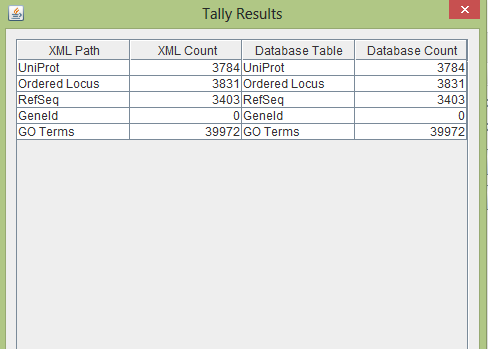Taur.vil Week 9
Week 9 Individual Journal
Digital Notebook
- Uniprot file for VC was downloaded and saved as VC_2013_10_22_TVKS.xml
- GOA file was saved as 46.V_cholerae_ATCC_39315_TVKS_2013_10_22.goa
- Direct download from wiki due to network connectivity problems.
- Downloaded GO OBO-SML and saved as go_daily-termdb_TVKS_2013_10_22.obo-xml
- Done using beta page and legacy download
Export Information
Version of GenMAPP Builder: 2.0b70
Computer on which export was run:BIOL 206, back right
- Then my personal lab top
Postgres Database name: VC_TVKS_2013_10_22_gmb2b70
UniProt XML filename: VC_2013_10_22_TVKS.xml
- UniProt XML version (The version information can be found at the UniProt News Page):
- Time taken to import: 8.31 minutes (4.55 on own computer)
GO OBO-XML filename: go_daily-termdb_TVKS_2013_10_22.obo-xml
- GO OBO-XML version (The version information can be found in the file properties after the file downloaded from the GO Download page has been unzipped):
- Time taken to import: 9.11 minutes on own computer
- Time taken to process: 7.60 min on own computer
GOA filename: 46.V_cholerae_ATCC_39315_TVKS_2013_10_22.goa
- GOA version (News on this page records past releases; current information can be found in the Last modified field on the FTP site):
- Time taken to import: 0.08 minutes
Name of .gdb file:
- Time taken to export .gdb:~3 hours
- started at 20:15, finished by 23:30
- Upload your file and link to it here. gdb export file
Note: Initially attempted on lab computer, but it was too slow and I switched to my own computer that evening.My personal computer was used for the rest of the week's analysis.
TallyEngine
Run the TallyEngine in GenMAPP Builder and record the number of records for UniProt and GO in the XML data and in the PostgreSQL databases (or you can upload and link to a screenshot of the results).
Tally verified expected results, the XML count matched the database count: 
Using XMLPipeDB match to Validate the XML Results from the TallyEngine
Follow the instructions found on this page to run XMLPipeDB match.
Are your results the same as you got for the TallyEngine? Why or why not?
Using XMLPipeDB Match, we initially found 2738 ordered loci using the first code listed bellow. However, when the command was changed to included VCA files (second bit of code), the actual results matched the expected at 3831.
"\Program Files <x86>\Java]jre7\bin\java" -jar xmlpipe-db-match-1.1.1.jar "VC_[0-9][0-9][0-9][0-9]" < VC_2013_20_22TVKS.xml
"\Program Files <x86>\Java]jre7\bin\java" -jar xmlpipe-db-match-1.1.1.jar "VC_(A|)[0-9][0-9][0-9][0-9]" < VC_2013_20_22TVKS.xml
Note: needed to include the full extension of java due to technicalities in the Win8 system.
Using SQL Queries to Validate the PostgreSQL Database Results from the TallyEngine
Follow the instructions on this page to query the PostgreSQL Database.
Our SQL query (bellow), found the expected 3831 ordered loci.
select count (*) when type='ordered locus' and value ~ 'VC_(A|)[0-9][0-9][0-9][0-9]'
OriginalRowCounts Comparison
Within the .gdb file, look at the OriginalRowCounts table to see if the database has the expected tables with the expected number of records. Compare the tables and records with a benchmark .gdb file.
Benchmark .gdb file: (for the Week 9 Assignment, use the "Vc-Std_External_20101022.gdb" as your benchmark, downloadable from here.
Copy the OriginalRowCounts table and paste it here:
Note:
Visual Inspection
Perform visual inspection of individual tables to see if there are any problems.
- Look at the Systems table. Is there a date in the Date field for all gene ID systems present in the database?
- Open the UniProt, RefSeq, and OrderedLocusNames tables. Scroll down through the table. Do all of the IDs look like they take the correct form for that type of ID?
Note:
.gdb Use in GenMAPP
Note:
Putting a gene on the MAPP using the GeneFinder window
- Try a sample ID from each of the gene ID systems. Open the Backpage and see if all of the cross-referenced IDs that are supposed to be there are there.
Note:
Creating an Expression Dataset in the Expression Dataset Manager
- How many of the IDs were imported out of the total IDs in the microarray dataset? How many exceptions were there? Look in the EX.txt file and look at the error codes for the records that were not imported into the Expression Dataset. Do these represent IDs that were present in the UniProt XML, but were somehow not imported? or were they not present in the UniProt XML?
Note:
Coloring a MAPP with expression data
Note:
Running MAPPFinder
Note:
Compare Gene Database to Outside Resource
The OrderedLocusNames IDs in the exported Gene Database are derived from the UniProt XML. It is a good idea to check your list of OrderedLocusNames IDs to see how complete it is using the original source of the data (the sequencing organization, the MOD, etc.) Because UniProt is a protein database, it does not reference any non-protein genome features such as genes that code for functional RNAs, centromeres, telomeres, etc.
Note:
Personal Template
- As part of Biological Databases
Please Remember the Harassing of Deities is Strictly Prohibited
Never Forget Samson